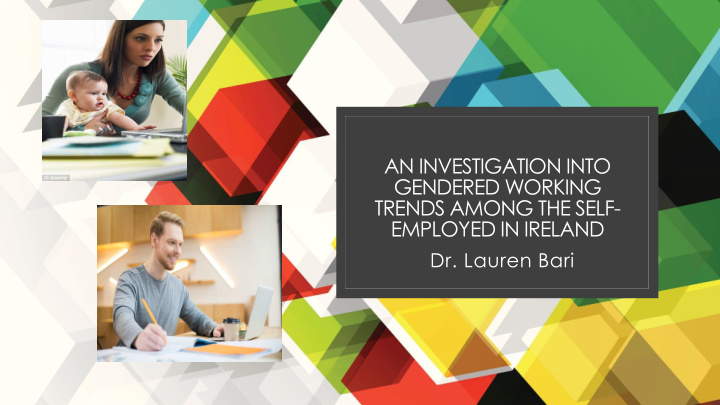



AN INVESTIGATION INTO GENDERED WORKING TRENDS AMONG THE SELF- EMPLOYED IN IRELAND Dr. Lauren Bari
Self-employment in Ireland (non-agricultural) gender breakdown Women – 25% of solo or freelance % self-employed in 2017 32,000 (up from 20, 600 in 2003) Women made up 39% of the 27,000 25 new business owners in Ireland in 2018 (GEM) Self-employed women are the most highly educated of any labour market group, with over 60% having at least degree level education 75% work at professional, technical 75 or managerial occupations Men Women
Thanks to greater time flexibility and increased opportunities to work from home, self-employment ‘It is possible that the growth can be a more viable option than Ireland is ‘no country of the “gig” economy could salaried employment for women help narrow the gender wage for working mothers’ with dependent children as it can gap in the economy.’ (Cooke (O’Hagan, 2015) reduce the cost of childcare’ at al, 2018) (European Institute for Gender Equality, 2014: 32) flexibility is a key driver of the self-employment decision for EU Strategy for Equality Between Men and women, offering the potential Women’ 2010-2015’ Aim to ‘to improve the to ‘work around’ family work-life balance, promoting female obligations (Richmond, 2017:6). entrepreneurship’
Gendered working trends among the self-employed Research Questions ◦ SOURCE: Labour Force Survey pooled cross sections of 2015 and 2017 data. • Are flexible working arrangements more ◦ SAMPLE: 1, 766 self- prevalent among self-employed women employed/402 women aged compared to self-employed men? 25-54 ◦ Frequency observations, hypothesis testing & logistic • How do gendered working trends among the regression models self-employed compare to those in wage-and- salaried work?
Gendered working trends among the self-employed Self-employed Wage and salaried workers Women n 402 Men % point difference Women Men % point difference n 1,364 n11, 724 n22, 673 Part-time 43 10 +33 27 8 +19 Works from home 47 32 +15 10 11 -1 Atypical hours 64 67 -3 41 51 -10 Care reasons 40 7 +33 34 5 +29 Personal/family reasons 28 13 +15 25 6 +19 Source: Labour Force Survey 2015 & 2017 sample weights applied Sample age 25-54 Note statistical significance
Gendered working trends among the self-employed W&S men W&S women SE men SE women 0 10 20 30 40 50 60 70 Caring reasons Work from home Atypical hours Part-time
Are there gender differences in how household and flexibility factors impact self-employment choice? The basic cross-sectional models estimate the probability of self-employment as a function of factors that might affect its utility under certain circumstances: p(SE)= βo+ β1 (F)+ β2 (FC)+ β3 (HC)+ ε
Model I Model II Results Women Men Women Men Married 1.397** 1.250** 1.261** 1.401** (.012) (.007) (.014) (.009) - Part-time work, atypical Children .924** 1.111** .927** p>.05 hours and working from (.011) (.005) (.011) Part time 2.527** 1.647** 3.933** 1.656** home strong and (.011) (.006) (.012) (.013) Atypical hours 2.451** 1.810** 2.724** 2.225** significant predictors of (.011) (.007) (.011) (.008) Home working 8.749** 3.895** 4.465** 3.460** self-employed status for (.009) (.005) (.011) (.009) women, more so than Professional/manager 4.550** 1.150** (.016) (.010) for men Degree or more .901** .687** (.011) (.009) - Effects of part-time work Profs, Sci, Tech, finance 2.340** 1.408** (.016) (.009) are strengthened when Health, Edu, Social .664** .284 (.016) (.013) human capital Industry, Construct .631** .525** attributes and industrial (.025) (.010) Constant .008 .048 .003 .043 sectors are controlled Observations 11, 336 11, 863 8, 602 8, 461 Pseudo R²* .154 .084 .206 .134 for Source: Labour Force Survey pooled cross sections 2015 and 2017 **significant at 99% confidence Odds ratio (Exp(B)) Reported. Standard errors in parentheses. Reference category for industrial groupings is “services” Sample age 25-54
Gender differences in the Model I Model II factors associated with part- Women Men Women Men Married 2.276** .547** 2.188** .510** time versus full-time self- employment (.026) (.028) (.026) (.028) Children 2.184** 1.003 2.268** 1.032 (.024) (.027) (.024) (.027) Degree or more .819** .836** (.027) (.032) Results: Professional 1.434** .559** - Marriage and children (.036) (.033) negatively associated Prof/Sci/Tech/Fin .781** .700** with part-time self- (.035) (.037) Industry/Manu .569** .788** employment for men (.057) (.037) but strongly and Health/Edu/Soc 1.260** 2.235** positively associated for (.034) (.045) women Constant .268 .160 .237 .263 Observations 321 764 - Effects remain when Pseudo R²* .114 .016 .135 .062 controlling for other Source: Labour Force Survey pooled cross sections 2015 and 2017 factors **significant at 99% confidence Odds ratio (Exp(B)) Reported. Standard errors in parentheses. Reference category for industrial groupings is “services” Sample age 25-54
Gendered trends in self-employment - conclusion There are professional, highly educated working mothers in Ireland seeking increased flexibility through freelance self-employment Self-employed men are not facing the same pressure to balance work and home Self-employed women are more likely than any other group to work part-time, from home and for reasons associated with family or caring concerns The gendered trends visible in the data on freelance work has implications for flexible working in general, particularly in the Covid19 era
Recommend
More recommend